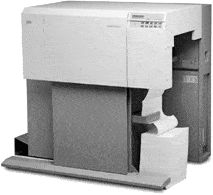The IBM InfoPrint 62 is a high-quality, continuous form laser printer:

- Entry-level system printer
- Flash fusing for efficient label printing
- Straight paper path for reliable printing on a wide variety of media
- Unique cutting design helps minimize paper waste
- Small footprint
Complex business environments require a flexible print solution that meets many diverse needs. Businesses need a traditional production printer that can print special forms and labels—all with exceptional print quality.

The IBM InfoPrint 62 helps to streamline supply chain management by ensuring that your products have accurate, legible labels that can be easily scanned.
The Infoprint 62 cost-effectively prints documents at the point-of-need. Print jobs can be submitted to the Infoprint 62 using a corporate intranet, providing easy access from all parts of your enterprise.
By supporting a wide range of paper, one IBM Infoprint 62 can replace several specialty printers.
Superior reliability
The IBM Infoprint 62 offers the reliability of a continuous-forms printer. The straight paper path minimizes operator intervention and allows the use of difficult-to-print, heavy stock and labels. Because the paper stays flat, labels are less likely to peel off, and heavy stock doesn’t tear at paper perforations. The printer uses noncontact, flash-fusing technology, which makes it ideal for both production printing and special forms printing, such as heavy stock, labels and ID cards.
The IBM InfoPrint 62 Has a Leading-Edge Controller
The IBM Infoprint 62 printer’s powerful Advanced Function Common Control Unit™ (AFCCU™) leverages IBM’s enhanced RISC System/6000® technology. Compressed images, graphics, outline fonts and printer generated bar codes can be processed and rendered at rated speeds.
User-friendly design
The printer’s auto load and auto unload features simplify paper management. The operator simply inserts the paper into the input tractors and it loads automatically when a job starts. At the end of a job, the printer cuts the paper and repositions the leading edge at the input tractors. This procedure simplifies paper handling and minimizes paper waste.
